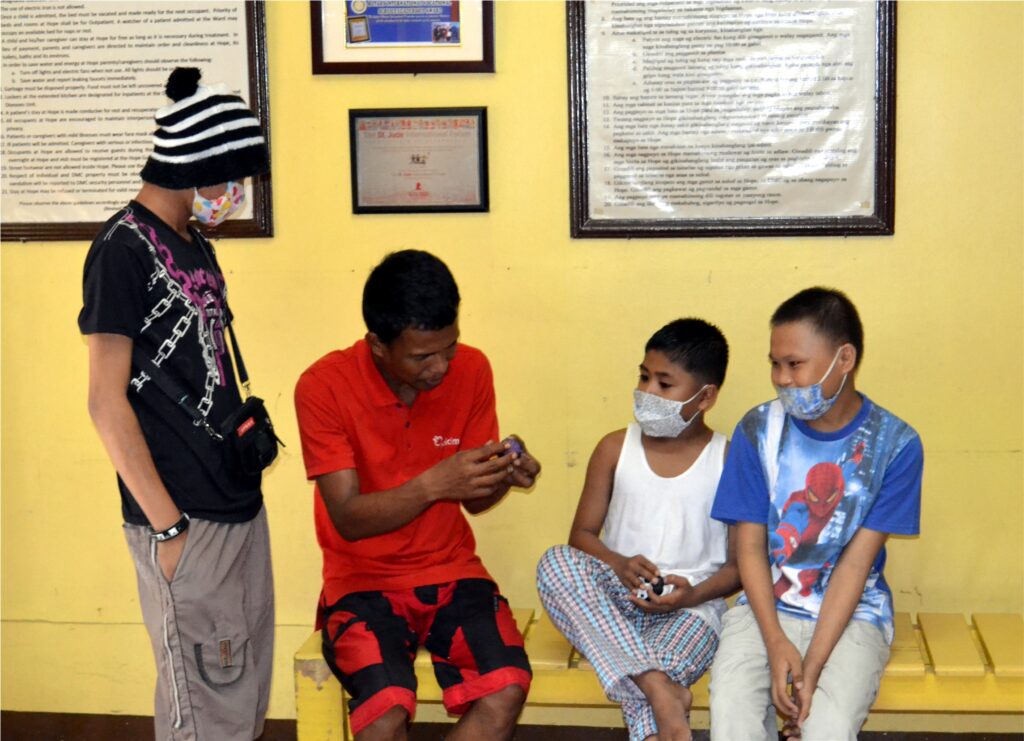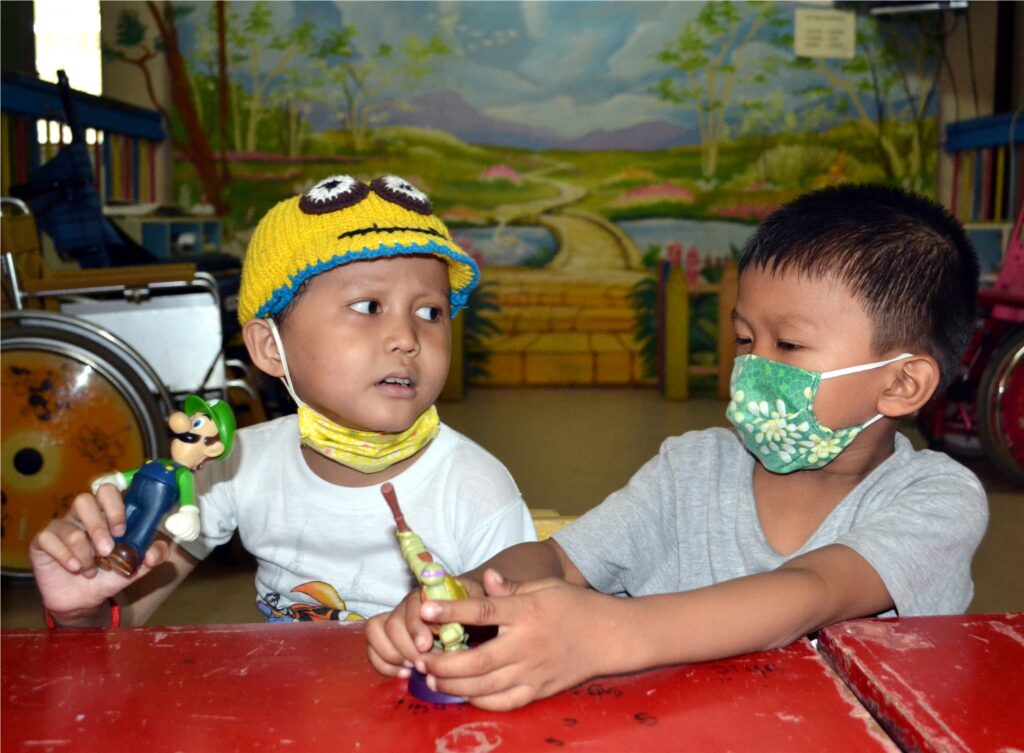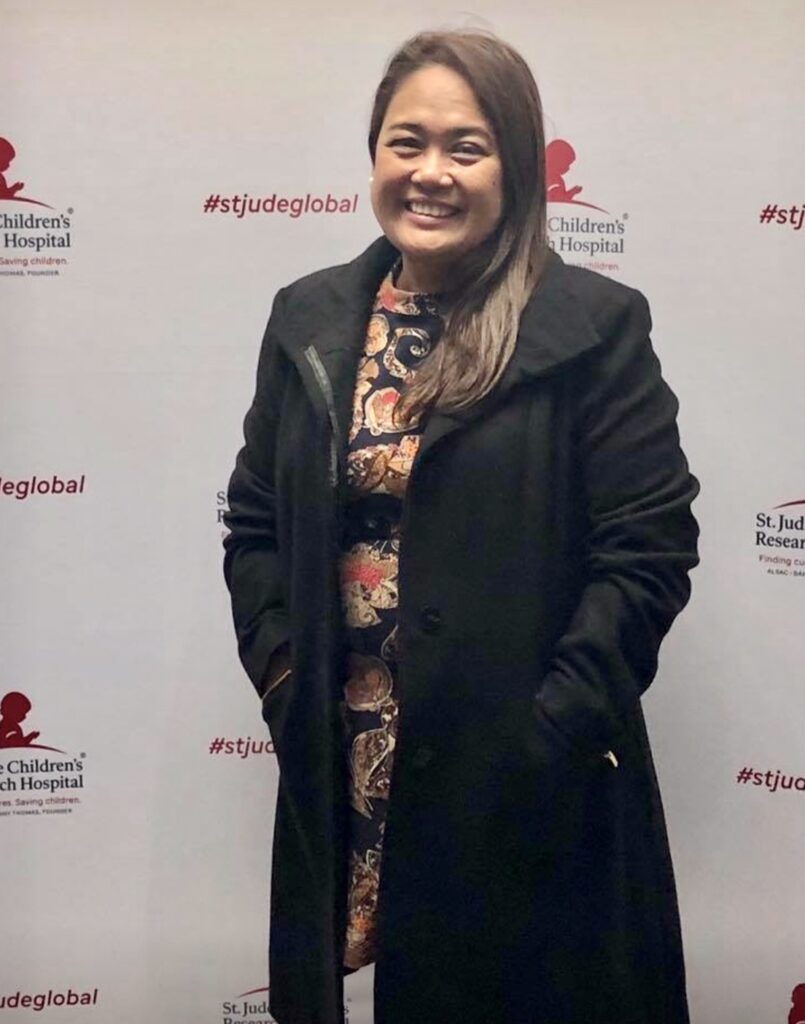Text and Photos by Henrylito D. Tacio
(Author’s note: The publication of the pictures for this feature is with the consent of the parents.)
Pikit, North Cotabato resident Libai was so happy that the baby girl she delivered was healthy. She named her “Talha.” But eight months later, she observed of a lump near the child’s sexual organ. She was worried, and so she brought her to the hospital. After several check-ups, the doctors said Libai’s child had malignant cancer. “She’s too young to have cancer,” said the devastated mother.
Rio brought her one-year-old son Miguel, whose stomach was swelling, to the public hospital in Amas, Kidapawan City. The doctors conducted an ultrasound and did several check-ups. Since the doctors had a hard time deciphering what was the problem with the little boy, they referred him to the Southern Philippine Medical Center in Davao City. The doctor’s diagnosis: rhabdomyosarcoma, a type of sarcoma (cancer of soft tissue).
Jaclyn from Esperanza, Sultan Kudarat, was only 14 when she was diagnosed of having cancer. The doctors advised that she should be operated on. She and her parents protested; they didn’t want her left hand to be cut. But when the pain was too much to bear, she decided to undergo the operation. For almost a year, “I was cancer-free,” she said. But in May 2014, cancer returned.
Cancer, a disease in which some of the body’s cells grow uncontrollably and spread to other parts of the body, claims millions of lives year after year. In fact, cancer is one of the leading killers around the world. It accounts for six million or 12% of deaths globally, according to the Geneva-based World Health Organization (WHO).
In the Philippines, where an estimated 107 million people live, over 4,700 children (aged 0 to 19 years) are expected to be diagnosed with cancer each year, with leukemia accounting for approximately 49% of childhood cancers, WHO reports.
Other types of cancers that strike Filipino children are cancers that affect the brain and nervous system (9.7%), lymph nodes (9%), retina (7.5%), kidney (3.4%), and bone and soft tissues gonadal and germ cell sites.
“Deaths from childhood cancer (in the Philippines) are estimated at 1,700 each year,” the United Nations health agency deplores. In the United States, more children die of childhood cancer than any other disease – more than Acquired Immune Deficiency Syndrome (AIDS), asthma, cystic fibrosis, congenital anomalies, and diabetes combined.
“Two-thirds of children treated for childhood cancer will suffer long-term effects from treatment including loss of hearing and sight, heart disease, secondary cancers, learning disabilities, infertility and more,” says the US-based St. Baldrick’s Foundation, which works closely with leading American pediatric oncologists.
Two years ago, the Philippines was designated by WHO as the first focus country in the Western Pacific for the Global Initiative for Childhood Cancer (GICC).
“The country was selected because of its tremendous efforts happening on the ground where the pediatric society and the civil society have mobilized such momentum on behalf of the patients and their families,” explained Dr. Catherine Lam, WHO Collaborating Center for Childhood Cancer co-director.

Bonding moments 
Two children with cancer 
Dr Mae Concepcion Dolendo
In a news report circulated by Philippine News Agency (PNA), Dr. Lam added that strong political commitment and foundation efforts supporting children with cancer as proven by the passage of twin health legislations – the Universal Health Care (UHC) Act and the National Integrated Cancer Control (NICC) Act.
Unfortunately, the Philippines is poorly equipped with dealing with the number of children with cancers. “The country has 130 hospitals treating with children but only three have dedicated pediatric oncology wards, of which two are in Metro Manila and one in Davao,” said Dr. Patricia Alcasabas, president of the Philippine Society of Pediatric Oncology.
Something must be done. “Recognizing the significantly increasing burden of childhood cancer that translates to lost potential, greater inequalities and economic hardship for the entire family, the GICC seeks to achieve at least a 60% survival rate for children with cancer globally by 2030. The Philippines joins a host of nations committing to saving lives and reducing suffering.”
Cancer is a rare disease among children, occurring in only one of 5,000 children every year. “The types of cancer that we see in children are different from adults,” says Dr. Mae Concepcion Dolendo, the head of the Children’s Cancer and Blood Diseases Unit of the Southern Philippine Medical Center (SPMC), the largest public hospital in Mindanao.
“Childhood cancers are usually embryonal or deep seated and aggressive while adult cancers are epithelial in origin and can be slow growing,” Dr. Dolendo explains. Epithelial tissue, which is made up of cells closely packed and range in one or more layers, covers the whole surface of the human body.
“In contrast to many adult cancers,” The Merck Manual of Medical Information states, “cancers in children tend to be much curable. About 75% of children with cancer survive at least 5 years.”
Unfortunately, in the Philippines, two-thirds of children with cancer are diagnosed at advanced stages, and abandonment of treatment is high at 80%, according to Dr. Julius A. Lecciones, executive director of the Philippine Children’s Medical Center.
“Although multi-disciplinary management is available and could potentially cure 80% of cases, only about 10% to 20% actually attains long-term survival,” Dr. Lecciones explains. “In our experience for many years, two-thirds of patients are in advanced stages of their cancer at the time of diagnosis. This is because childhood cancer in the Philippines is not detected early enough for cure to be possible.”
In his paper, “The Global Improvement of Childhood Cancer Care in the Philippines,” Dr. Lecciones cites three obstacles to early detection and effective management of childhood cancer in the country.
These are: (1) subtle signs are not recognized promptly by frontline physicians at the primary levels of care; (2) patients and/or parents delay medical consultations, or when diagnosed will not opt for treatment; and; (3) for those who seek medical attention, there is no appropriate cancer treatment facility in the locality, or the parents do not know where to go to seek treatment.
“Due to financial reasons, those who are positively diagnosed to have cancer are not treated adequately with only one in five patients receiving gold standard treatment, mostly as paying patients,” Dr. Lecciones states.
Childhood cancer isn’t just one disease. “There are over a dozen types of childhood cancer and countless subtypes, each requiring specific research to develop the best treatment for every child,” says St. Baldrick’s Foundation.
Early detection is one of the best ways to beat childhood cancer. “Malignancies in children are difficult to detect because they may present similarly as other common childhood diseases,” says the Department of Health (DOH).
The health department urges parents should to have their children undergo a regular medical check-up and be alerted to the following symptoms which may be associated with cancer in children: prolonged, unexplained fever or illness; unexplained pallor; increased tendency to bruise, unexplained localized pain, or limping; unusual masses or swelling; frequent headaches, often with vomiting; sudden eye or visual changes; sudden or progressive weight loss.
According to Dr. Dolendo, childhood cancers are also very aggressive but are very sensitive to treatment. “Overall survival for childhood leukemia is more than 90% in developed countries and almost 80% for all other cancers,” she says.
Unlike adult cancers, childhood cancers are not given much prominence. “I think childhood cancer is a significant problem among Filipinos because we have a relatively young population and children comprise 40% of our population,” Dr. Dolendo laments.
“I would like to point out though that childhood cancer is still relatively uncommon accounting to only 10% of all cancers and 90% being adult cancers,” she adds. “In Mindanao, we expect about 1,000 new cases to be diagnosed every year.”
Unfortunately, of the 1,000 news cases annually, only 200-250 are diagnosed and able to access treatment.
As in adults, doctors use a combination of treatments, including surgery, chemotherapy, and radiation therapy. “Children who survive cancer have more years than adults to develop long-term consequences of chemotherapy and radiation therapy, such as infertility, poor growth, damage to the heart, and even development of second cancers (which occurs in 3% to 12% of children who survive cancer),” the Merck manual says.
“Because of these significant possible consequences and complexity of treatment, children with cancer are best treated in centers with expertise in childhood cancers,” the Merck manual points out.
“Childhood cancer treatment is complex and long term,” Dr. Dolendo agrees. “Our solid tumor patients go through surgery, chemotherapy and radiotherapy when necessary. Standard treatment protocols for solid tumors span 6 months to two years of repeated visits to the hospital.”
Children with acute lymphoblastic leukemia, for instance, are treated for two-and-a-half years. “And there are the necessary hospital admissions in between chemotherapy when patients are treated for infection, receive transfusions, or go through evaluation work ups,” Dr. Dolendo says. “There are also repeated outpatient visits for check-ups and chemotherapy.”
Dr. Dolendo also runs the House of Hope, which was launched in 2007 and is located inside the SPMC.
“We tried to compute for the total cost of treatment for all patients and we found that chemotherapy alone in the duration of our standard all treatment costs more than P300,000 per patient for chemotherapy medicines alone,” Dr. Dolendo says.
The aforementioned cost does not include blood products, supportive care medicines, and hospitalizations. “Despite having similar diagnosis, every individual patient responds differently from other patients so the costs of care may vary with some patients admitted more than others,” Dr. Dolendo says.
Unfortunately, almost 80% of their patients come in late stages of the disease with many complications, which further escalate the cost of care.
It’s no wonder the odds of surviving childhood cancer in the country are significantly lower compared with those in industrialized countries like the United States. But since Dr. Dolendo started her work as a lead pediatric oncologist at SPMC, survival rates have increased from 10% in 2004 to 50% currently.
Dr. Dolendo has her own way of treating childhood cancer: she combines science with art. Her method is to care not only for the child patient but also to support the family that surrounds the child. “We must never forget that the family is responsible for a lot of things for a child,” she reminds.

